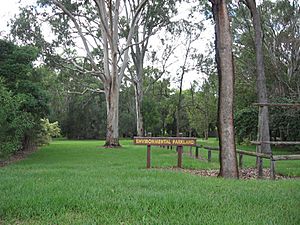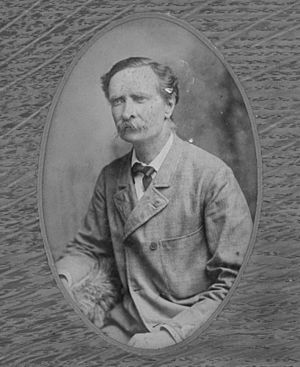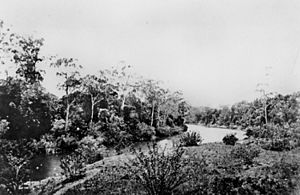Oaklands Sugar Mill facts for kids
Quick facts for kids Oaklands Sugar Mill |
|
|---|---|

Oaklands looking east from Captain Whish Ave along northern boundary, 2010
|
|
| Location | 68 Captain Whish Avenue, Morayfield, Moreton Bay Region, Queensland, Australia |
| Design period | 1840s - 1860s (mid-19th century) |
| Built | 1865 |
| Official name: Oaklands Sugar Mill Remnants, Whish's Sugar Mill Remnants | |
| Type | archaeological |
| Designated | 18 September 2009 |
| Reference no. | 645607 |
| Significant period | 1865-1872 (sugar mill); 1873-1990 (agriculture and grazing) |
| Significant components | building foundations/ruins |
| Lua error in Module:Location_map at line 420: attempt to index field 'wikibase' (a nil value). | |
The Oaklands Sugar Mill is a historic site in Morayfield, Australia. It holds the remains of an old sugar cane mill that was built in 1865. This site is also known as Whish's Sugar Mill Remnants. It was added to the Queensland Heritage Register in 2009 because of its important history.
Contents
The Story of Oaklands Sugar Mill
The Oaklands sugar mill worked for a short time, from 1865 to 1872. It was built and run by Claudius Buchanan Whish. He was one of the first people in Queensland to sell sugar in large amounts. The mill processed sugar cane grown on his Oaklands property. Many workers from the Pacific Islands helped harvest the cane.
The mill stopped making sugar in 1872. This was because the weather in southern Queensland was not warm enough for sugar cane to grow well in winter. Also, bigger and better sugar farms were starting up in places like Maryborough and Mackay.
Early Sugar Growing in Queensland
Sugar cane first arrived in southern Queensland around 1836. People started growing small amounts in the Moreton Bay area. Between 1836 and 1847, some clever people tried to see if sugar cane could be a good crop for the colony. They tested different types of sugar cane in the Brisbane botanic gardens.
Louis Hope was a pioneer in growing sugar in Queensland. He started a sugar farm at his Ormiston House Estate in 1862. In 1864, he built Queensland's first sugar crushing mill. It was supplied by a company from Glasgow. The first sugar made in a mill in Queensland was produced there in September 1864.
The Caboolture area was one of the first places in Queensland where a lot of sugar was grown. George Raff, a well-known Brisbane businessman and politician, began planting sugar at his Morayfield farm in 1864.
Captain Whish and Oaklands
Captain Claudius Buchanan Whish was inspired by the success of Hope and Raff. Whish had been an officer in the British army in India. He decided to start a new life in Australia. After seeing other sugar farms, Whish chose land on the southern side of the Caboolture River. He named his property Oaklands. He also hired John Buhot, who was an expert, to advise him on planting his farm.
In 1865, Whish partnered with John Raymond Trevilian for his Oaklands farm. Whish needed many workers to grow enough sugar cane to sell. After talking to other sugar farmers, Trevilian traveled to Melanesia to find workers.
Workers from the Pacific Islands
In December 1865, 33 workers from the Pacific Islands came to Australia. They arrived at Oaklands after traveling by bullock cart from the North Pine River. Whish reportedly paid about £7 for each worker. They lived in a building called the cotton house and were given milk and rice.
Whish was not only a pioneer in the sugar industry. He was also one of the first to use workers from the Pacific Islands. This was only two years after Robert Towns first brought these workers to Australia for his cotton farm.
Building the Mill
The use of Pacific Islander workers at Oaklands was successful at first. With a lot of sugar cane growing, Whish got enough money to build a sugar mill at Oaklands in 1865. In 1866, he bought a six-horsepower mill from Smellie & Co in Brisbane. He also installed other important equipment like a Wetzel pan and a centrifuge.
The mill also had a boiler, three rollers for crushing cane, and brick structures for boiling. There was a boiling room and a curing room on the site. The sugar processing area was in the middle of the farm. Whish also got a special license to make rum from molasses, which is a byproduct of sugar.
Growth and Challenges
The sugar operations at Oaklands continued to do well. In 1867, Whish replaced the first group of 33 workers with 50 new ones. He paid £150 in advance for them. That same year, his farm had a large house, a manager's house, and cottages and huts for the workers. There was also a big store, a blacksmith's shop, stables, and a carriage house.
By 1869, Whish had about 90 acres (36 ha) of sugar cane growing at Oaklands. He had another 26 acres (11 ha) near Moreton Bay. In 1871, Whish built a proper building to house his Pacific Islander workers, showing how much he valued them.
However, the early success at Oaklands did not last. The climate was a bit too cool for sugar cane to grow well in the winter. Also, sugar farms further north, around Maryborough and Mackay, produced more sugar and grew faster.
The End of Sugar Production
As early as 1870, rum and other products from Whish's distillery were being sold at lower prices. To try and keep the sugar business going, they thought about forming a company. But by 1872, Oaklands stopped making sugar.
In February 1872, much of the mill's equipment was put up for sale. Many of the machines were bought by the Mackenzie brothers. They moved the equipment to their sugar operations in north Queensland. The Oaklands site was sold in September 1873. After that, it was used for farming and grazing animals until 1990, when it became an environmental reserve.
What You Can See Today
The remains of the Oaklands Sugar Mill are located in a small park east of Captain Whish Avenue. This park is owned by the Moreton Bay Regional Council. This land was part of the original property that Claudius Whish bought in 1865 and named "Oaklands."
You can see important historical features at the site. There are bricks still in place that might be the foundations of a large building or for the milling machines. There are also four large dips in the ground. Next to these dips are piles of bricks. These dips might have been rooms, compartments, or tanks that were underground. The bricks look like they were made by hand. You can also see some guava trees growing there.
The exact size of the old mill area is not fully clear. It might extend beyond the low wooden fence that is there now. Modern houses are built next to the site to the north and south. It's possible that parts of the sugar mill were once in those areas. However, any remains there would likely have been disturbed when the houses were built.
Why Oaklands Sugar Mill is Important
The remains of the Oaklands Sugar Mill are important for several reasons, which is why they are on the Queensland Heritage Register.
- Early Sugar History: The site shows us about the early history of farming in the Caboolture area. It is also an example of one of the first sugar industry developments in Queensland. It represents one of the earliest attempts to make sugar for sale in Queensland.
- Developing Industries: Even though the mill only operated for a short time (1865-1872), its early successes helped the sugar industry grow in other parts of Queensland. It shows how people tried to start new industries in the region.
- Connected to a Key Person: The site is linked to Captain Claudius Buchanan Whish. He was a very important person in the early sugar industry in Queensland. He was one of the first to sell large amounts of sugar and good quality rum. He also later became a member of the Queensland Parliament.
- Early Use of Pacific Islander Labour: The remains are a rare reminder of how workers from the Pacific Islands were used in southeast Queensland. These workers were employed at Oaklands starting in 1865, only two years after they were first brought to Queensland. The site can help us learn about early work practices and how they might have changed over time.
- Learning About Sugar Production: The Oaklands site has a lot of potential to teach us about how sugar was made back then. Early sugar farms often tried new ways of doing things. Comparing Oaklands, which eventually failed, with more successful farms can show us how producers adapted to different environments and how sugar production changed over time.
- Hidden History: There might be many more historical items hidden underground at the site. Even though houses have been built nearby, there is no sign that the main park area has been greatly disturbed since the mill closed. The visible bricks, mounds, and dips suggest that there are substantial building foundations just below the surface.
- Research Potential: There isn't much written information about how the sugar was processed at Whish's Oaklands farm. By studying the available documents and doing more archaeological digs at the site, we could learn important things. This includes early sugar processing methods, technologies, and the working conditions for Pacific Islander labourers on Queensland sugar farms. Digging at the site could also reveal new information about the mill's layout and where other buildings were located.



